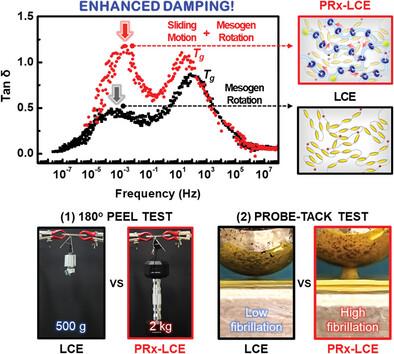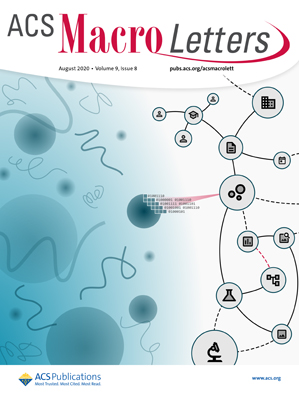Harnessing Extreme Internal Damping in Polyrotaxane-Incorporated Liquid Crystal Elastomers for Pressure-Sensitive Adhesives
IF 5.1
Q1 POLYMER SCIENCE
引用次数: 0
Abstract
Liquid crystal elastomers (LCEs) exhibit extraordinary energy dissipation due to their unique viscoelastic response, resulting from the rotation of mesogens under mechanical stress. While recent studies demonstrate the LCE-based pressure-sensitive adhesives (PSAs) by exploiting the enhanced damping, all previous studies have focused on LCEs with covalent crosslinks. Here, a new class of PSAs is developed by integrating movable polyrotaxane crosslinkers into an LCE matrix (PRx-LCEs). Dynamic viscoelastic measurements reveal that PRx-LCE exhibits a remarkably high energy dissipation, as indicated by a large tan δ. Interestingly, the secondary tan δ peak associated with LCE damping is more pronounced than the primary peak of the glass transition. The exceptional energy dissipation in PRx-LCE results in superior adhesion strength (≈1864 N m−1), which is 3.5 times higher than conventional LCEs and 13 times higher than commercial PSAs in the peel test. Additionally, PRx-LCEs demonstrate thermally reversible adhesion, enabling clean removal at elevated temperatures. Furthermore, the sliding effect in PRx-LCE enhances both deformability and stress relaxation under load, resulting in deeper indentation, and superior adhesion during the probe tack test. The combination of LCE and slidable crosslinks provides robust and switchable adhesion, making them promising for applications in biomedical engineering, display, and semiconductor industries.

利用掺入聚二十八烷的液晶弹性体中的极端内部阻尼制造压敏粘合剂
液晶弹性体(LCE)因其独特的粘弹性响应而表现出非凡的能量耗散能力,这种响应是介质在机械应力作用下旋转产生的。最近的研究表明,基于液晶弹性体的压敏粘合剂(PSA)可以利用其增强的阻尼作用,但之前的研究都集中在具有共价交联的液晶弹性体上。本文通过在 LCE 基体(PRx-LCEs)中加入可移动的聚二十六烷交联剂,开发了一类新型压敏胶。动态粘弹性测量结果表明,PRx-LCE 具有极高的能量耗散能力,这体现在其具有较大的 tan δ 值。有趣的是,与 LCE 阻尼相关的 tan δ 次峰比玻璃化转变的主峰更为明显。PRx-LCE 卓越的能量耗散性能带来了超强的粘附强度(≈1864 N m-1),在剥离测试中比传统 LCE 高出 3.5 倍,比商用 PSAs 高出 13 倍。此外,PRx-LCE 还具有热可逆粘附性,可在高温下清洁去除。此外,PRx-LCE 中的滑动效应还能增强负载下的变形能力和应力松弛,从而使压痕更深,并在探针粘性测试中获得优异的粘附性。LCE 与可滑动交联的结合提供了稳健且可切换的粘附性,使其有望应用于生物医学工程、显示和半导体行业。
本文章由计算机程序翻译,如有差异,请以英文原文为准。
求助全文
约1分钟内获得全文
求助全文
来源期刊
CiteScore
10.40
自引率
3.40%
发文量
209
审稿时长
1 months
期刊介绍:
ACS Macro Letters publishes research in all areas of contemporary soft matter science in which macromolecules play a key role, including nanotechnology, self-assembly, supramolecular chemistry, biomaterials, energy generation and storage, and renewable/sustainable materials. Submissions to ACS Macro Letters should justify clearly the rapid disclosure of the key elements of the study. The scope of the journal includes high-impact research of broad interest in all areas of polymer science and engineering, including cross-disciplinary research that interfaces with polymer science.
With the launch of ACS Macro Letters, all Communications that were formerly published in Macromolecules and Biomacromolecules will be published as Letters in ACS Macro Letters.

 求助内容:
求助内容: 应助结果提醒方式:
应助结果提醒方式:


